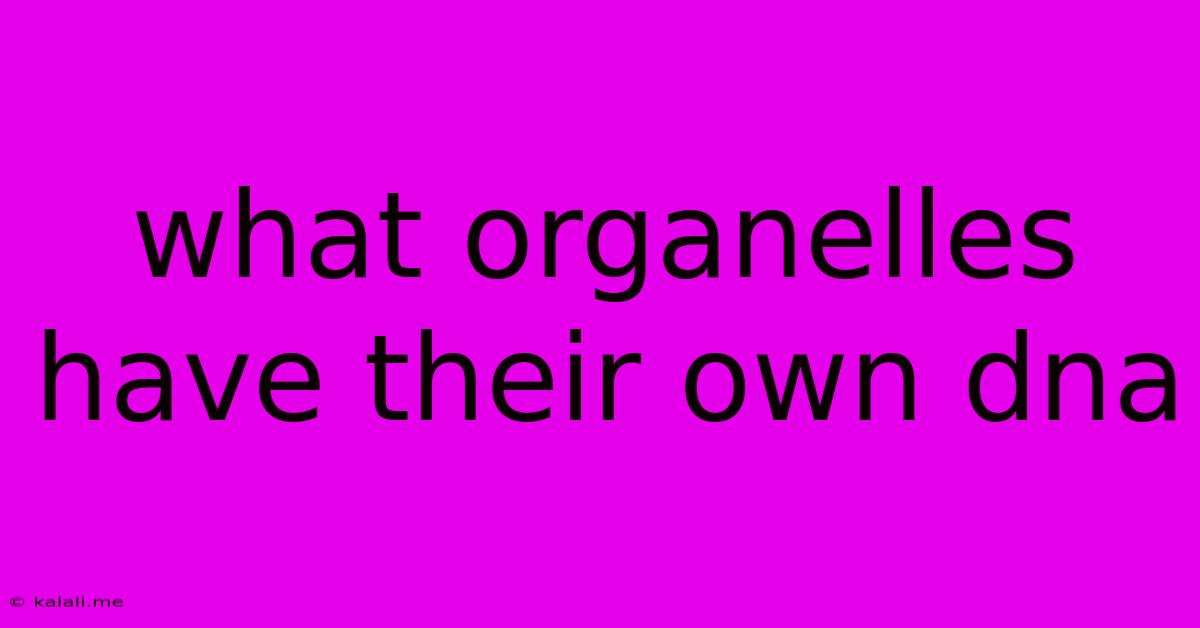What Organelles Have Their Own Dna
Kalali
Jun 15, 2025 · 3 min read

Table of Contents
What Organelles Have Their Own DNA? A Deep Dive into Cellular Autonomy
The cell, the fundamental unit of life, is a bustling metropolis of intricate structures, each performing specific tasks to maintain the organism's survival. Within this cellular city, certain organelles possess a remarkable degree of independence: they contain their own DNA, separate from the cell's nuclear genome. This fascinating characteristic hints at their evolutionary origins and highlights their crucial roles in cellular function. Understanding which organelles boast their own genetic material is key to comprehending the complexities of cellular biology.
Mitochondria: The Powerhouses with a Past
Arguably the most well-known organelle with its own DNA, mitochondria are often referred to as the "powerhouses" of the cell. These oblong structures are responsible for generating adenosine triphosphate (ATP), the cell's primary energy currency, through cellular respiration. The mitochondrial genome, or mtDNA, is a small, circular molecule encoding a limited number of genes primarily involved in oxidative phosphorylation – the process of ATP production. The presence of mtDNA strongly supports the endosymbiotic theory, which posits that mitochondria were once free-living bacteria that were engulfed by an ancestral eukaryotic cell and formed a mutually beneficial symbiotic relationship. This theory is further bolstered by the fact that mitochondrial ribosomes resemble those found in bacteria, rather than eukaryotic ribosomes. Mitochondrial dysfunction has been linked to various diseases, highlighting the critical role of these energy-producing organelles.
Chloroplasts: The Solar-Powered Factories
Exclusive to plant cells and some protists, chloroplasts are the sites of photosynthesis – the process of converting light energy into chemical energy in the form of sugars. Like mitochondria, chloroplasts possess their own circular DNA molecule, known as cpDNA. This cpDNA encodes genes essential for photosynthesis, including those for the proteins involved in light harvesting and carbon fixation. The presence of cpDNA and the structural similarities between chloroplasts and cyanobacteria (photosynthetic bacteria) further solidify the endosymbiotic theory, suggesting chloroplasts also originated from an ancient symbiotic event. Chloroplast biology is crucial to understanding plant growth, development, and the global carbon cycle.
Other Organelles and Nuclear DNA's Influence
While mitochondria and chloroplasts are the most prominent examples of organelles with their own DNA, it's important to note that the vast majority of cellular functions are directed by the nuclear genome. The nuclear DNA contains the genetic instructions for the synthesis of the proteins responsible for the structure and function of all other organelles, including those that don’t have their own DNA.
Key Differences and Similarities
| Feature | Mitochondria | Chloroplasts |
|---|---|---|
| Primary Function | ATP production | Photosynthesis |
| DNA Shape | Circular | Circular |
| Gene Content | Oxidative phosphorylation | Photosynthesis proteins |
| Location | Cytoplasm | Cytoplasm (plant cells) |
In Conclusion:
The existence of organelles with their own DNA provides compelling evidence for the endosymbiotic theory and illuminates the fascinating evolutionary history of eukaryotic cells. While mitochondria and chloroplasts are the primary examples, understanding their unique genetic makeup and function is crucial to appreciating the complexity and elegance of cellular biology and the intricate interplay between different cellular compartments. Further research continues to unravel the nuances of organelle genetics and its implications for various biological processes.
Latest Posts
Latest Posts
-
Arrange The Following In The Correct Sequence
Jun 15, 2025
-
What Are All The Factors Of 81
Jun 15, 2025
-
Which Of The Following Is Not A Parameter
Jun 15, 2025
-
Who Is The Father Of Humanism
Jun 15, 2025
-
An Alpha Particle Is The Same As A
Jun 15, 2025
Related Post
Thank you for visiting our website which covers about What Organelles Have Their Own Dna . We hope the information provided has been useful to you. Feel free to contact us if you have any questions or need further assistance. See you next time and don't miss to bookmark.